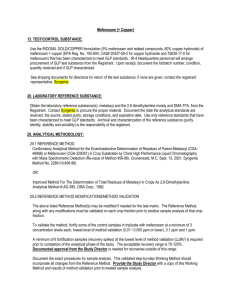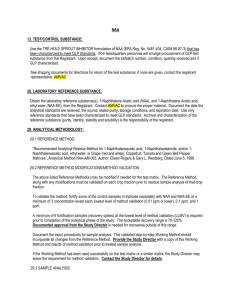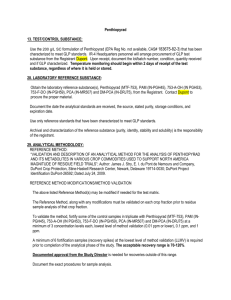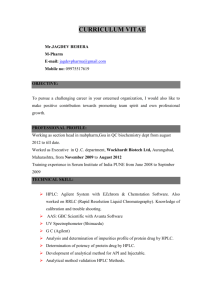good laboratory practice
advertisement
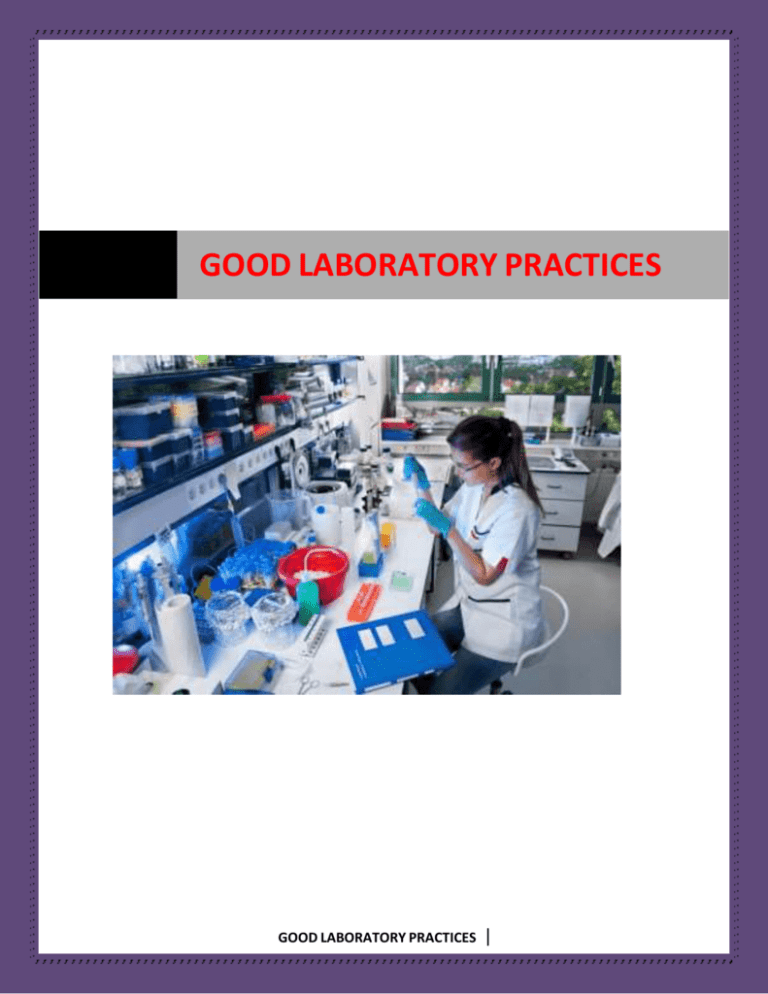
GOOD LABORATORY PRACTICES GOOD LABORATORY PRACTICES | GOOD LABORATORY PRACTICE In the experimental (non-clinical) research arena, the phrase good laboratory practice or GLP specifically refers to a quality system of management controls for research laboratories and organizations to try to ensure the uniformity, consistency, reliability, reproducibility, quality, and integrity of chemical (including pharmaceuticals) non-clinical safety tests; from physio-chemical properties through acute to chronic toxicity tests. GLP was first introduced in New Zealand and Denmark in 1972, and later in the US in 1978 in response to the Industrial BioTest Labs scandal. It was followed a few years later by the Organisation for Economic Co-operation and Development (OECD) Principles of GLP in 1992; the OECD has since helped promulgate GLP to many countries. GLP applies to non-clinical studies conducted for the assessment of the safety or efficacy of chemicals (including pharmaceuticals) to man, animals and the environment. An internationally recognized definition of GLP can be found on the website for the Medicines and Healthcare products Regulatory Agency-UK which defines GLP as: Good Laboratory Practice (GLP) embodies a set of principles that provides a framework within which laboratory studies are planned, performed, monitored, recorded, reported and archived. These studies are undertaken to generate data by which the hazards and risks to users, consumers and third parties, including the environment, can be assessed for pharmaceuticals (only preclinical studies), agrochemicals, cosmetics, food additives, feed additives and contaminants, novel foods, biocides, detergents etc.... GLP helps assure regulatory authorities that the data submitted are a true reflection of the results obtained during the study and can therefore be relied upon when making risk/safety assessments. GLP, a data quality system, should not be confused with standards for laboratory safety appropriate gloves, glasses & clothing to handle lab materials safely. CONTENTS 1 History 2 The OECD 3 OECD Guidelines for the Testing of Chemicals 4 The US FDA 5 European Union 6 Non-OECD member-countries 7 Criticism 8 Klimisch score 9 Automated systems 10 Notes and references 11 See also 12 External links HISTORY GLP was first introduced in New Zealand and Denmark in 1972. GLP was instituted in US following cases of fraud generated by toxicology labs in data submitted to the FDA by pharmaceutical companies. Industrial BioTest Labs (IBT) was the most notable case, where thousands of safety tests for chemical manufacturers were falsely claimed to have been performed or were so poor that police investigators could not piece together what work had been done...even though IBT superficially delivered the test results their contracts with the manufacturers specified. These issues were made public in the hearings at the US Congress, which led to the FDA’s publication of Proposed Regulations on GLP in 1976, with establishment of the Final Rule in June 1979 (21 CFR 58). The Environmental Protection Agency (EPA) had also encountered similar problems in data submitted to it, and issued its own draft GLP regulations in 1979 and 1980, publishing the Final Rules in two separate parts (40 CFR 160 and 40 CFR 792) in 1983. The OECD Following Decision C(97),186/Final of the OECD Council, data generated in the testing of chemicals in one OECD Member Country, in accordance with OECD Test Guidelines and the Principles of GLP are accepted in all other OECD Member Countries. OECD: EMV/MC/CHEM(98)17 part two GLP is a quality system concerned with the organisational process and conditions under which non-clinical health and environmental safety studies are planned, performed, monitored, recorded, archived and reported. GLP principles include 1. Organization and Personnel Management-Responsibilities Sponsor-Responsibilities Study Director-Responsibilities Principal Investigator-Responsibilities Study Personnel-Responsibilities 2. Quality assurance program Quality Assurance Personnel 3. Facilities Test System Facilities Facilities for Test and Reference Items 4. Equipment, reagents and Materials 5. Test systems Physical/Chemical Biological 6. Test & Reference items 7. Standard operating procedures 8. Performance of Study Study Plan Conduct of Study 9. Reporting of results 10. Archival - Storage of Records and Reports OECD Guidelines for the Testing of Chemicals OECD publishes OECD Guidelines for the Testing of Chemicals, which are guidelines that usually have to be followed for GLP compliance. They are widely required by agencies doing risk assessments of chemicals. The US FDA The United States FDA has rules for GLP in 21CFR58. Preclinical trials on animals in the United States of America use these rules prior to clinical research in humans. Research in the US not conducted under these restrictions or research done outside US not conducted according to the OECD Guidelines (or FDA rules) might be inadmissible in support of a New Drug Application in the US. FAMOUS EXAMPLE One of the labs that went under such an investigation made headline news. The name of the Lab was Industrial Bio Test. This was a big lab that ran tests for big companies such as Procter and Gamble. It was discovered that mice that they had used to test cosmetics such as lotion and deodorants had developed cancer and died. Industrial Bio Test lab threw the dead mice and covered results deeming the products good for human consumption. Those involved in production, distribution and sales for the lab eventually served jail time. European Union Since 1987 the European Council had adopted two basic Directives and a Decision relating to the application of the GLP principles. Directive 2004/10/EC has replaced Directive 87/017/EEC as of 11 March 2004; Directive 2004/9/EC has replaced Directive 88/320/EEC as of 11 March 2004. " Directive 2004/10/EC of the European Parliament and of the Council of 11 February 2004 on the harmonisation of laws, regulations and administrative provisions relating to the application of the principles of good laboratory practice and the verification of their applications for tests on chemical substances." This directive lays down the obligation of the Member States to designate the authorities responsible for GLP inspections in their territory. It also comprises requirements for reporting and for the internal market (i.e., mutual acceptance of data). " Directive 2004/9/EC of the European Parliament and of the Council of 11 February 2004 on the inspection and verification of good laboratory practice (GLP)". The Directive requires that the OECD Revised Guides for Compliance Monitoring Procedures for GLP and the OECD Guidance for the Conduct of Test Facility Inspections and Study Audits must be followed during laboratory inspections and study audits. 89/569/EEC Council Decision of 28 July 1989 on the acceptance by the European Economic Community of an OECD decision / recommendation on compliance with principles of good laboratory practice. There are also 'Product Oriented Directives' referring to GLP obligations: REACH Regulation of 18 December 2006 and Directive 2006/121/EC of 18 December 2006 Medicinal products; Directive 2001/83/EC on the Community code relating to medicinal products for human use of 6 November 2001 as amended by Commission Directive 2003/63/EC Veterinary Medicinal Products; Directive 2001/82/EC of the European Parliament and of the Council of 6 November 2001 on the Community code relating to veterinary medicinal products Cosmetics; Council Directive 93/35/EEC amending for the 6th time directive 76/768/EEC Feedingstuffs; Regulation (EC) No 1831/2003 of the European Parliament and of the Council of 22 September 2003 on additives for use in animal nutrition Foodstuffs; Directive 89/107/EEC Novel Foods and novel food ingredients; Regulation (EC) No 258/97 of the European Parliament and of the Council of 27 January 1997 concerning novel foods and novel food ingredients Pesticides; Council Directive 91/414/EEC of 15 July 1991 concerning the placing of plant protection products on the market Biocides; Directive 98/8/EC of the European Parliament and of the Council of 16 February 1998 concerning the placing of biocidal products on the market Detergents; Directive 98/8/EC Regulation (EC) No 648/2004 of the European Parliament and of the Council of 31 March 2004 on detergents EC Ecolabel; Commission Decision 2005/344/EC of 23 March 2005; establishing ecological criteria for the award of the Community eco-label to all-purpose cleaners and cleaners for sanitary facilities In the meantime the EU has concluded Mutual Acceptance Agreements in the area of GLP with Israel, Japan and Switzerland. By means of the Treaty of the European Economic Area of 13 September 1993, the European Regulations and Directives also apply to Iceland, Liechtenstein and Norway. Non-OECD member-countries An inspection in non-member economies by OECD inspectors will not guarantee that data generated in compliance with GLP will be accepted in other member countries than the one to which they are submitting data and which has thus sent inspectors to verify the accuracy of their compliance statement. Criticism GLP regulations require adequately qualified personnel, adequate facilities, a single qualified study director for each study, a quality assurance unit, adequate test system care facilities, characterized test articles/test items, equipment that has been proven to perform as required and is adequately inspected, cleaned and maintained, standard operating procedures approved by management (not QA), proper documented care of test systems, a study protocol/plan with specified content approved by the study director,and a study report with specified content. The GLP regulations require documentation of any laboratory worksheets, records, memoranda, notes or exact copies thereof, that are the result of original observations and activities of a non-clinical laboratory study and are necessary for the reconstruction and evaluation of the report of that study and an archive for orderly storage and expedient retrieval of all raw data, documentation, protocols/plans, and specimens generated as the result of a non-clinical laboratory study. Although it is good scientific practice to assure equipment is functioning properly, people are qualified, data are recorded properly, etc... Even though hundreds of facilities around the world, including developing countries, have demonstrated the capability to successfully perform GLP compliant studies, others continue to argue these good scientific practices are too difficult for them to satisfy. Some researchers make the argument that since studies that do not meet these quality standards may be published in peer reviewed scientific journals, good science may be performed without GLP compliance. It is accurate to state that compliance with GLP regulations does not assure good science. Since good and bad science may be performed GLP compliant or non-GLP, this argument misdirects the discussion from the reason why the GLPs are required: to protect public health and safety. Because the data and reports of non-clinical safety studies are used to make public health decisions, it is necessary that these studies can be reconstructed from data that has the integrity, and GLP ensures the integrity of the data. Klimisch score The Klimisch score system tries to rank the reliability of toxicity studies for use by risk assessors (regulatory agencies). It was published in 1997, by BASF (a chemical company) authors.Studies performed according to GLP are assigned the top rank of 1 (reliable without restriction) and are preferred by agencies. When no GLP study is available for a particular endpoint, a study with a rank of 2 is usually accepted by an agency. Lower ranks typically require a new study to be performed. Klimisch scoring is very widely used in chemical risk assessments. Critics say it is a self-interested bias on objectivity, that a quality system from the regulated party gives their own GLP-complying studies the top rank. Automated systems In many instances, the optimal recommended 'no-argument' means of implementing GLP is to develop an automated approach to both Sample Preparation and Sample Measurement. If this can include an overarching 'chain of custody' sample history and data flow, combined with adequate SOP's for calibration & linearization of measuring tools, GLP compliance is virtually assured. Implementing GLP on an automated system, as an intellectual and labour-intensive task, requires a GxP company to make a great amount of effort. To ease the burden of this management, Webster et al. have provided a tutorial for users to quickly embark on and do the job properly. Certain Manufacturers & Vendors of Laboratory Instrumentation and/or Laboratory Automation are well-versed in assisting with the application of GLP (and 21CFR11) to their commercial offerings. Overview Scientific measurements (whether they pertain to monitoring contaminants in pharmaceutical products, clinical determinations of blood sugar, characterization of forensic evidence, or testing materials for space missions) are generally recognized as affecting decisions literally concerned with life and death issues. As personal acknowledgement of their responsibility, scientists have traditionally adopted sound laboratory practices directed at assuring the quality of their data. However, until recently these practices were not consistently adopted, enforced, or audited. Because of some notorious historic examples where erroneous data have lead to tragic consequences, national and international agencies have developed guidelines directed at various industries (food, agriculture, pharmaceutical, clinical, environmental, etc.) which fall in the general category of Good Laboratory Practices (GLP). Within the USA, federal agencies such as FDA and EPA have produced documents defining laboratory operational requirements which must be met so that technical data from laboratory studies may be acceptable by those agencies for any legal or contractual purposes. Laboratories doing business with or for these agencies must therefore comply with the specified GLP regulations. So crucial has the issue of maintaining compliance become that many industries report no less than 10%, and occasionally as much as 50%, of their total effort is expended on internal quality assurance. A typical level of effort is 25%. Because the issue of GLP is obviously so crucial to modern laboratory operations, but most importantly because good laboratory practice is an essential ingredient for any professional scientist, this course will incorporate many of the principles that are part of GLP in contemporary laboratories. A brief summary of GLP principles is presented below. Elements of Good Laboratory Practice Quality Assurance; Establishing Confidence in Reported Data. The primary products of any laboratory concerned with chemical analysis are the analytical data reported for specimens examined by that laboratory. Quality assurance (QA) for such a laboratory includes all of the activities associated with insuring that chemical and physical measurements are made properly, interpreted correctly, and reported with appropriate estimates of error and confidence levels. QA activities also include those maintaining appropriate records of specimen/sample origins and history (sampletracking), as well as procedures, raw data, and results associated with each specimen/sample. The various elements of Quality Assurance are itemized here: o Standard Operating Procedures (SOP's). o Statistical procedures for data evaluation o Instrumentation validation o Reagent/materials certification o Analyst certification o Lab facilities certification o Specimen/Sample tracking Many volumes could be written regarding each of the QA elements itemized above. However, we can only discuss each briefly here. SOP's are what the name implies...procedures which have been tested and approved for conducting a particular determination. Often, these procedures will have been evaluated and published by the regulatory agency involved (e.g., EPA or FDA); these agencies may not accept analytical data obtained by other procedures for particular analytes. Within the context of your student laboratory work, the experimental procedures provided in your Laboratory Manual correspond to the SOP's for this course. Within any commercial laboratory, SOP's should either be available or developed to acceptable standards, so that any analytical data collected and reported can be tied to a documented procedure. Presumably, this implies that a given determination can be repeated at any later time, for an identical specimen, using the SOP indicated. Statistical procedures for data evaluation are covered in the lecture part of this course, and will not be repeated here. It should be pointed out, however, that one may not be able simply to select a statistical procedure from a textbook. Many procedural details are optional and arbitrary. Thus, practitioners in a particular field (e.g., agricultural chemistry, clinical chemistry, etc.) may adopt certain standards which are deemed acceptable within that field (e.g., using 95% or 99% confidence levels for particular tests); or they may adopt specific statistical analysis procedures for defining detection limits, confidence intervals, analyte measurement units, etc. Regulatory agencies often describe acceptable statistical procedures also. Instrumentation validation is a process inherently necessary for any analytical laboratory. Data produced by "faulty" instruments may give the appearance of valid data. These events are particularly difficult to detect with modern computer-controlled systems which remove the analyst from the data collection/instrument control functions. Thus, it is essential that some objective procedures be implemented for continuously assessing the validity of instrumental data. These procedures, when executed on a regular basis, will establish the continuing acceptable operation of laboratory instruments within prescribed specifications. Time-related graphical records of the results of these instrument validation procedures are called "control charts". An example of a control chart documenting performance of a student laboratory instrument is included below. The "control limits" assigned as upper and lower ranges around the expected instrumental output are generally related to some accepted measure of the random error expected for the overall procedure. (Typically the control limits will be set at +/- 2(std. dev.). Quality assurance procedures will require that whenever a instrument's performance is outside of the "control limits", use of that instrument to provide analytical reports must be discontinued; the cause of the problem must be determined and fixed if possible; and the instrument must be certified to be operating again with control limits before returning to service for determinations leading to reported analytical data. Reagent/materials certification is an obvious element of quality assurance. However, GLP guidelines emphasize that certification must follow accepted procedures, and must be adequately documented. Moreover, some guidelines will specify that each container for laboratory reagents/materials must be labeled with information related to its certification value, date, and expiration time. This policy is meant to assure that reagents used are as specified in the SOP's. Certification of analysts is a required part of QA. Some acceptable proof of satisfactory training and/or competence with specific laboratory procedures must be established for each analyst. Because the American Chemical Society does not currently have a policy regarding "certification" of chemists or analysts, the requirements for "certification" vary, and are usually prescribed by the laboratory in question. These standards would have to be accepted by any agency or client obtaining results from that laboratory. For our student laboratory, the requirement for certification as an analyst is satisfactory completion of the first three laboratory assignments (see lab outline, Series A). Execution of these basic procedures will be repeated, if necessary, until satisfactory results are obtained (evaluated based on analytical accuracy and precision). Certification of laboratory facilities is normally done by some external agency. For example, an analytical laboratory might be audited by representatives of a federal agency with which they have a contract. An independent laboratory might file documentation with a responsible state or federal agency. The evaluation is concerned with such issues as space (amount, quality and relevance), ventilation, equipment, storage, hygiene, etc. Student chemistry laboratories are generally evaluated by the American Chemical Society, as part of the process of granting approval for the overall chemistry program presented by the college or university. This latter approval process is not as detailed regarding analytical facilities as the certification processes pursued by agencies concerned specifically with quality assurance. Specimen/sample-tracking is an aspect of quality assurance which has received a great deal of attention with the advent of computer-based Laboratory Information Management Systems (LIMS). However, whether done by hand with paper files, or by computer with modern bar-coding techniques, sample-tracking is a crucial part of quality assurance. The terms "specimen" and "sample" are often used interchangeably. However, "specimen" usually refers to an item to be characterized chemically; whereas "sample" usually refers to a finite portion of the specimen which is taken for analysis. When the specimen is homogeneous (such as a stable solution), the sample represents the overall composition of the specimen. However, for heterogeneous specimens (e.g., metal alloys, rock, soil, textiles, foods, polymer composites, vitamin capsules, etc.), a sample may not represent the overall composition. Maintaining the distinction in records of analytical results can be crucial to the interpretation of data. Procedures for assuring adequate specimen/sample-tracking will vary among laboratories. The bottom line, however, is that these procedures must maintain the unmistakable connection between a set of analytical data and the specimen and/or samples from which they were obtained. In addition, the original source of the specimen/sample(s) must be recorded and likewise unmistakably connected with the set of analytical data. Finally, in many cases the "chain-of-custody" must be specified and validated. This is particularly true for forensic samples (related to criminal prosecution), but can also be essential for many other situations as well. For example, a pharmaceutical company developing a new product may be called upon at some time to defend their interpretation of clinical trial tests. Such defense may require the company to establish that specimens collected during these trials could not have been deliberately tampered. That is, they may have to establish an unbroken chain-of-custody which would remove all doubt regarding the integrity of specimens submitted to chemical analysis. Documentation and Maintenance of Records. A central feature of GLP guidelines is the maintenance of records...of specimen/sample-origins, chain-of-custody, raw analytical data, processed analytical data, SOP's, instrument validation results, reagent certification results, analyst certification documents, etc. Maintenance of instrument and reagent certification records provides for post-evaluation of results, even after the passage of several years. Maintenance of all records specified provide documentation which may be required in the event of legal challenges due to repercussions of decisions based on the original analytical results. So important is this record-keeping feature of GLP that many vendors are now providing many of these capabilities as part of computer packages for operating modern instruments. For example, many modern computer-based instruments will provide for the indefinite storage of raw analytical data for specific samples in a protected (tamper-proof) environment. They also provide for maintenance of historical records of control chart data establishing the operational quality of instruments during any period during which analytical data have been acquired by that instrument. The length of time over which laboratory records should be maintained will vary with the situation. However, the general guidelines followed in regulated laboratories is to maintain records for at least five years. In practice, these records are being maintained much longer. The development of higher density storage devices for digitized data is making this kind of record-keeping possible. The increasing frequency of litigation regarding chemistry-related commercial products is making this kind of record-keeping essential. Moreover, establishing the integrity of the stored data is becoming a high level security issue for companies concerned about future litigation. All of the ingredients of record-keeping described above are captured in the scientists' traditional maintenance of a Laboratory Notebook. The details for maintenance of a lab notebook for this course are provided in a later section. Accountability. GLP procedures inherently establish accountability for laboratory results. Analysts, instruments, reagents, and analytical methods can not (and should not) maintain the anonymity that might be associated with a lack of GLP policy. Responsibility for all aspects of the laboratory processes leading to technical results and conclusions is clearly defined and documented. This situation should place appropriate pressure on analysts to conduct studies with adequate care and concern. Moreover, it allows the possibility of identifying more quickly and succinctly the source(s) of error(s) and taking corrective action to maintain acceptable quality of laboratory data. GLP for the Chem 55 Laboratory. It is not appropriate to implement a full complement of GLP policies for a student laboratory, as the experimental studies are not related to a commercial product. However, it is useful to incorporate those GLP policies which are fundamental to any sound laboratory work, and to provide an introduction to GLP policies that are a part of any contemporary commercial laboratory. Thus, the following GLP policies will be implemented for the Chem 55 course (detailed in the following two sections): o analyst certification, based on satisfactory performance of basic set of analytical procedures (Series A) o performance of laboratory studies utilizing SOP's (Series A to D) o instrument validation (Series C) o reagent certification (Series D) o laboratory notebook maintenance to contemporary standards o maintenance of laboratory records based on instrument and reagent certifications o accountability for instrument and reagent certification REFERENCES http://www.sjsu.edu/faculty/chem55/55glpout.htm http://www.labcompliance.com/tutorial/glp/default.aspx?sm=d_a UGA Office of the Vice President for Research Wikipedia


